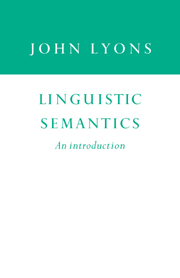Book contents
- Frontmatter
- Contents
- Preface
- List of symbols and typographical conventions
- Part 1 Setting the scene
- Part 2 Lexical meaning
- 2 Words as meaningful units
- 3 Defining the meaning of words
- 4 The structural approach
- Part 3 Sentence-meaning
- Part 4 Utterance-meaning
- Suggestions for further reading
- Bibliography
- Index
3 - Defining the meaning of words
Published online by Cambridge University Press: 05 June 2012
- Frontmatter
- Contents
- Preface
- List of symbols and typographical conventions
- Part 1 Setting the scene
- Part 2 Lexical meaning
- 2 Words as meaningful units
- 3 Defining the meaning of words
- 4 The structural approach
- Part 3 Sentence-meaning
- Part 4 Utterance-meaning
- Suggestions for further reading
- Bibliography
- Index
Summary
INTRODUCTION
How does one set about defining the meaning of words? In this chapter, we shall see that different answers can be given to this question. We shall also see that different answers can be given for different kinds of words.
For some words, especially nouns such as ‘table’ or ‘chair’ in English, one might think that a version of the so-called referential theory of meaning, mentioned in Chapter 1, is perfectly satisfactory: one might think that they can be readily defined by identifying what they stand for. Some theorists have taken this view; and it is well represented in the literature of both linguistic and philosophical semantics. It is undoubtedly a reasonable view to take, at least for words that stand for such things as dogs and cats, or tables and chairs; and it is commonly such words that are used to exemplify, not only the referential theory, but also complementary or alternative theories of lexical meaning.
But how does one define or identify what a word stands for? Is it possible to say what one word stands for without employing other semantically related words in doing so and without saying in what respect these semantically related words are similar to one another in meaning and in what respects they differ? And what exactly does the traditional expression ‘stand for’ mean in this context? As we shall see in the following section, we have to distinguish what expressions denote from what they can be used to refer to: we have to distinguish denotation from reference.
- Type
- Chapter
- Information
- Linguistic SemanticsAn Introduction, pp. 75 - 101Publisher: Cambridge University PressPrint publication year: 1995



